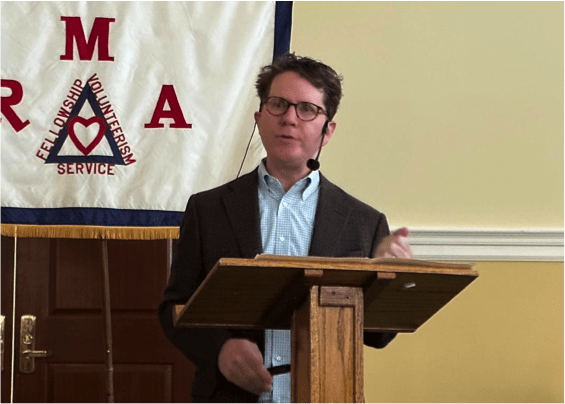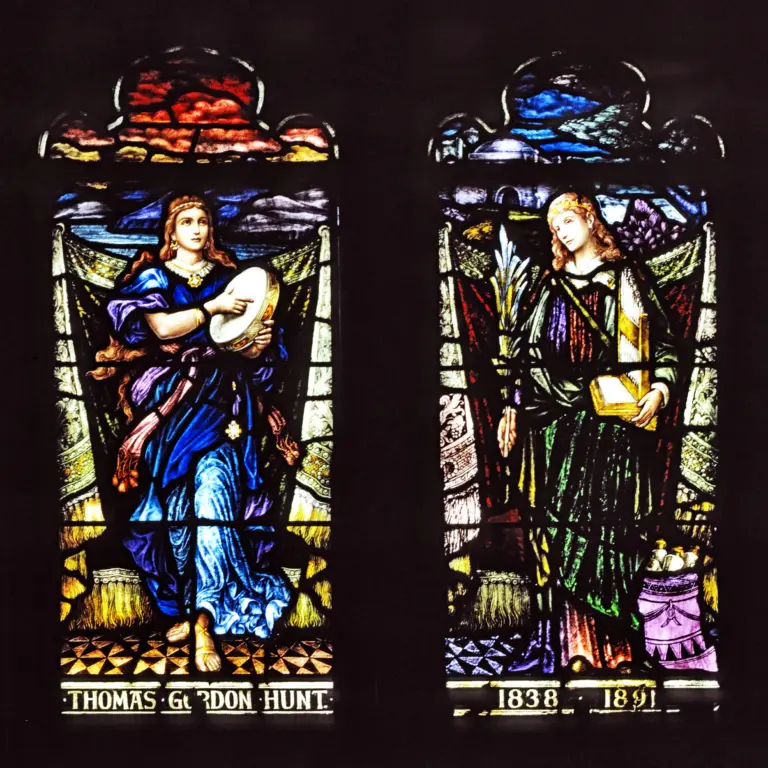
By Retired Men’s Association of Greenwich
At the Retired Men’s Association of Greenwich’s meeting on March 29, Horst Tebbe of the RMA introduced Dr. C. Griffith Mann, the Metropolitan Museum of Art’s Michel David-Weill Curator in Charge of the Department of Medieval Art and The Cloisters. Dr. Mann is responsible for the medieval collections and curatorial staff in the Met’s main building and for directing the staff and operations at The Cloisters, the branch of the Met dedicated to the art and architecture of medieval Europe. He was formerly the Deputy Director and Chief Curator at the Cleveland Museum of Art. Dr. Mann is a 1987 graduate of Greenwich High School. He received his B.A. in art history and history from Williams College and his Ph.D. in medieval art from The Johns Hopkins University. A specialist in the arts of late medieval Italy, he has published on civic patronage, painting, and devotion in Tuscany.
Dr. Mann began his presentation focusing on the history of The Cloisters, which is located in upper Manhattan, majestically situated on a hilltop with a spectacular view of the Hudson River and the Palisades in New Jersey. The Cloisters resulted from the collaboration of three men in the early twentieth century: John D. Rockefeller, George Gray Barnard, and William Wells Bosworth.
Rockefeller was well-acquainted with, and enamored of the area that now is Fort Tryon Park, having ridden horses there in his youth. He acquired a major estate there in 1917, thinking at the time that the property might be better used as a public place than as a private residence. When a fire destroyed the estate, that transition became all the more likely.
Barnard was a sculptor who studied under Rodin, and he was taken by medieval art. He was particularly inspired by what he labeled the “patient Gothic chisel.” He began buying medieval works and accumulated a substantial collection that he housed at an unimposing site he called George Gray Barnard’s Cloisters, which was located about a mile-and-a-half south of its current namesake. Barnard was hired to create sculptures on one of Rockefeller’s properties, and the two men got to know each other. While working for Rockefeller, Barnard told him that he had encountered an extraordinary set of medieval tapestries that are now known as the Unicorn Tapestries that were for sale. Rockefeller then asked Bosworth, an accomplished architect best known for the main building at MIT, for his opinion on the tapestries. When Bosworth enthusiastically endorsed Barnard’s view of the tapestries’ magnificence, Rockefeller examined them, bought them for about a million dollars, and donated them to the Met after they adorned his apartment in Manhattan for a time.
Rockefeller facilitated The Met’s purchase of Barnard’s Cloisters, and The Met then housed the Unicorn Tapestries there. Rockefeller, however, had reserved the right to control where they were housed, and he decided that they should be kept at a grander venue. In 1933 he initiated construction of The Cloisters at its current location, and that building was opened to the public in 1938. The Unicorn Tapestries – and thousands of other pieces of medieval art – have been displayed there since that time. The Cloisters itself is a work of art, designed to look like a medieval building and resplendent with beautiful gardens.
Dr. Mann then talked about the Unicorn Tapestries themselves. They appear to date from about the year 1500 in Brussels, but it is unknown who created them. They are probably the product of a workshop at which numerous artists and artisans worked on them, and even with this group effort they would have taken several years – perhaps a decade or more – to complete. Some background figures appear nearly identical to those in other works dating to that time, suggesting that they were produced by the same hand or studio. Unfortunately, the creators of these other works are also unknown. The earliest documentation regarding the tapestries was a 1728 inventory of a French castle that was sacked in 1793 during the French revolution, and the tapestries were then lost for several decades. They were returned to the family in the 1850’s.
The creation of the tapestries was an arduous process. It probably began with the creation of a “cartoon” – a drawing, perhaps full-sized, that guided the weavers as they proceeded. The principal materials were wool, silk, and metallic threads. Colors were generated using dyes created from three plants mixed in various proportions, along with human urine, to create the palette for the artists. Dr. Mann marveled at the intricate designs that were generated by meticulously weaving the colored threads.
The tapestries depict a hunt for a unicorn, a creature said to be imbued with great strength that could be captured only when a maiden entered the forest and caused it to relax its guard, at which time a hunter in hiding could overcome it.
Dr. Mann then shifted to explaining the efforts to restore the second great set of tapestries at The Cloisters, the Hero Tapestries. These tapestries depict nine great heroes: three pagan heroes (Hector of Troy, Alexander the Great, and Julius Caesar), three Jewish (Joshua, David, and Judas Maccabeus), and three Christian (King Arthur, Charlemagne, and Godfrey of Bouillion). They appear to date to about 1400 and to have been created in the South Netherlands.
Dr. Mann then took several questions from the audience after he had delivered to the attendees a much deeper appreciation of these works of medieval art and what goes into preserving them.
To see the full presentation, go to https://greenwichrma.org, cursor to “Speakers” and click on “Speaker Videos.”
The RMA’s next presentation, “Piano Classics from Around the World: Recital with Commentary” will be given by Dr. Jose Niell who was born in Argentina, has been a Connecticut resident since 1967 and has been playing the piano since the age of eight. He has pursued his love for music by studying piano throughout his years as a practicing physician in Stamford, CT. He has a degree in Medicine from the University of Cordoba in Argentina and completed his U.S. Medical Fellowship Program at Yale University. He retired from medicine in 2010.
Dr. Niell will present a wide-ranging program with insightful commentary that will include a piece by Domenico Scarlatti, a Neapolitan composer from the early 18th century. His second piece will be by Emmanuel Chabrier, a Frenchman who composed during the second half of the 19th century and was an important influence on Debussy, Ravel and Poulenc. Next, he will play two pieces by the Argentine composer Julian Aguirre who had a distinctive nationalist style giving voice to folk tunes, rhythms, and harmonies from his native Argentina. Aguirre’s pieces will be followed by “Cordoba” by Isaac Albeniz, an allegory of the ancient city in southern Spain and its Islamic history. Dr. Niell will then play “The Miller’s Dance” from a work by Maestro Manuel de Falla. He will end his presentation by playing Valse in E minor by Chopin and then concluding with a piece by Franz Liszt. As a member of the Senior Men’s Association of Stamford, Dr. Niell has performed three piano recitals.
This informative presentation will occur on Wednesday, April 12 at 11:00 a.m. at the First Presbyterian Church in Greenwich as well as on webinar at: https://bit.ly/30lBj21.
RMA speaker presentations are presented as a community service at no cost to in-person or Zoom attendees, regardless of gender. The RMA does request that all eligible individuals consider becoming a member of our great organization, and thereby enjoy all the available fellowship, volunteer and community service opportunities that the RMA offers to its members. For further information, visit https://greenwichrma.org or contact Joe Mancinelli (mailto:jlmanc@optonline.net) or Peter Stern (mailto:members@greenwichrma.org).
Note: The views expressed in these RMA presentations are those of the speakers. They are not intended to represent the views of the RMA or its members.




